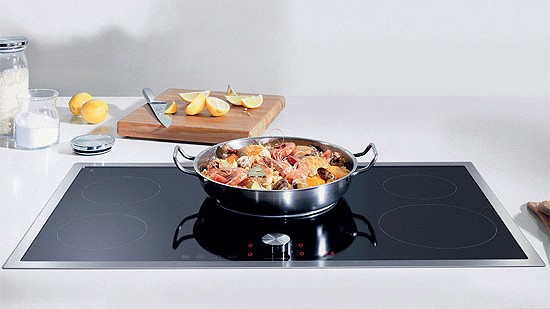A Guide to Induction Hobs
Cook up a storm in the kitchen with a sleek, chic induction hob. Here's what you need to know...


Fast, clean, safe and loved by culinary professionals, induction cooking is rapidly gaining in popularity and accessibility. Although induction hobs appeared more than 20 years ago, and have since been embraced by top chefs, because they offer fast, flame-free cooking, manufacturers have only recently developed easy-to-use, competitively priced models. A basic four-zone touch control hob now costs about half what it would have done five years ago.
How they work
An induction element (what on a gas stove would be called a burner) is a powerful, high-frequency electromagnet, the magnetic qualities of which are generated by electronics under the unit's ceramic surface. When a pan made from a magnetic material is placed in the magnetic field, the field transfers, or induces, energy into that metal. That transferred energy causes the pan to heat up - and the heat can be raised or lowered instantly by adjusting the strength of the magnetic field, so a rapidly boiling pan can be reduced to a simmer in about two seconds. Once the pan is lifted away, the heating zone switches off. All induction hobs include a power-boost button that will boil a pan of water in around 90 seconds.
Why buy induction?
If you can only have an electric hob, induction is a more efficient choice than ceramic, halogen or solid plate electric, because of its instantaneous heating and cooling - which gives it slightly lower running costs, too. Induction hobs are an ideal replacement for an old electric hob, as there's no need for special wiring (though you are legally required to use a qualified electrician to install the hob).
Other benefits include the fact that induction hobs are easier to clean than either gas or ceramic, controllable heat means pans very rarely boil over anyway, and an absence of a naked flame means there is a reduced risk of fire.
Making the Choice
Sign up to our newsletter for style inspiration, real homes, project and garden advice and shopping know-how
Basic hobs have two large and two small heating zones; five and six zone models are also available. Work out how big a heating area you want, and choose a hob with heating zones positioned to suit the way you like to cook. Extra features to look out for include a child lock, to protect young children, and a timer for long-simmering or time-critical foods. As we know how difficult it is to find your way through the maze of available options, we've selected some of the latest hobs to come on to the market to give you a feel for what's out there.
There's plenty of space on the induction hob from Whirlpool, which has a sizeable keep-warm zone in addition to its four induction zones. Features include touch control, power levels from 1 to 9, boost, a timer and a child lock.
A memory setting means you can programme up to five cooking processes on the induction hob from Miele. The hob has five zones with power levels from 1 to 12, touch controls, a timer, a boost button and a safety lock.
One of seven new models by Neff , the Point & Twist control has five zones, all with timers. It also has a keep-warm setting and a child lock.
Gaggenau's induction hob has five flexible cooking areas with 17 power levels and a memory function.
If you've no place to fit a standard induction hob, then try Belling's handy little Pronto portable model. It can be used outdoors if plugged into an RCCB socket and has four settings, touch controls and comes with a cast-iron griddle and a pan.
The MaxiSense Competence induction hob by AEG-Electrolux has no marked zones but four large induction areas. It has touch controls, 15 power levels, four timers and a child lock.
The largest hob is the De Dietrich range. It has five zones and 15 cooking levels, as well as special features such as 'Start Control', which enables the user to programme the hob to switch on and cook at a given time for a given period at a given heat. There's a timer on all zones and a child lock for the touch controls.
The induction hob from Smeg fits into a 60cm cut-out. It has four cooking zones, a boost, a timer and a child lock.
Saucepans
Induction will only work with pans that attract a magnet, so any offer of free pans with a hob can be worthwhile.
Marco Pierre White's Range stainless-steel pans are by Beka. The White Heat Collection also includes a non-stick range suitable for use with induction. Not recommended for dishwashers.
The Privilege range from Tefal is dishwasher safe and non-stick.
Making the Choice
Basic hobs have two large and two small heating zones; five and six zone models are also available. Work out how big a heating area you want, and choose a hob with heating zones positioned to suit the way you like to cook. Extra features to look out for include a child lock, to protect young children, and a timer for long-simmering or time-critical foods. As we
know how difficult it is to find your way through the maze of available options, we've selected some of the latest hobs to come on to the market to give you a feel for what's out there.
There's plenty of space on the induction hob from Whirlpool, which has a sizeable keep-warm zone in addition to its four induction zones. Features include touch control, power levels from 1 to 9, boost, a timer and a child lock.
A memory setting means you can programme up to five cooking processes on the induction hob from Miele. The hob has five zones with power levels from 1 to 12, touch controls, a timer, a boost button and a safety lock.
One of seven new models by Neff , the Point & Twist control has five zones, all with timers. It also has a keep-warm setting and a child lock.
Gaggenau's induction hob has five flexible cooking areas with 17 power levels and a memory function.
If you've no place to fit a standard induction hob, then try Belling's handy little Pronto
portable model. It can be used outdoors if plugged into an RCCB socket and has four settings, touch controls and comes with a cast-iron griddle and a pan.
The MaxiSense Competence induction hob by AEG-Electrolux has no marked zones but four large induction areas. It has touch controls, 15 power levels, four timers and a child lock.
The largest hob is the De Dietrich range. It has five zones and 15 cooking levels, as well as special features such as 'Start Control', which enables the user to programme the hob to switch on and cook at a given time for a given period at a given heat. There's a timer
on all zones and a child lock for the touch controls.
The induction hob from Smeg fits into a 60cm cut-out. It has four cooking zones, a boost, a timer and a child lock.

Thea Babington-Stitt is the Assistant Editor for Ideal Home. Thea has been working across some of the UK’s leading interiors titles for nearly 10 years.
She started working on these magazines and websites after graduating from City University London with a Masters in Magazine Journalism. Before moving to Ideal Home, Thea was News and Features Editor at Homes & Gardens, LivingEtc and Country Homes & Interiors.